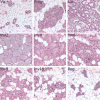Mammary gland involution as an immunotherapeutic target for postpartum breast cancer
- PMID: 24952477
- PMCID: PMC4363120
- DOI: 10.1007/s10911-014-9322-z
Mammary gland involution as an immunotherapeutic target for postpartum breast cancer
Abstract
Postpartum mammary gland involution has been identified as tumor-promotional and is proposed to contribute to the increased rates of metastasis and poor survival observed in postpartum breast cancer patients. In rodent models, the involuting mammary gland microenvironment is sufficient to induce enhanced tumor cell growth, local invasion, and metastasis. Postpartum involution shares many attributes with wound healing, including upregulation of genes involved in immune responsiveness and infiltration of tissue by immune cells. In rodent models, treatment with non-steroidal anti-inflammatory drugs (NSAIDs) ameliorates the tumor-promotional effects of involution, consistent with the immune milieu of the involuting gland contributing to tumor promotion. Currently, immunotherapy is being investigated as a means of breast cancer treatment with the purpose of identifying ways to enhance anti-tumor immune responses. Here we review evidence for postpartum mammary gland involution being a uniquely defined 'hot-spot' of pro-tumorigenic immune cell infiltration, and propose that immunotherapy should be explored for prevention and treatment of breast cancers that arise in this environment.
Figures




Similar articles
-
Wound healing-like immune program facilitates postpartum mammary gland involution and tumor progression.Int J Cancer. 2015 Apr 15;136(8):1803-13. doi: 10.1002/ijc.29181. Epub 2014 Sep 15. Int J Cancer. 2015. PMID: 25187059 Free PMC article.
-
Non-steroidal anti-inflammatory drugs target the pro-tumorigenic extracellular matrix of the postpartum mammary gland.Int J Dev Biol. 2011;55(7-9):745-55. doi: 10.1387/ijdb.113379jo. Int J Dev Biol. 2011. PMID: 22161831
-
Alternatively activated macrophages and collagen remodeling characterize the postpartum involuting mammary gland across species.Am J Pathol. 2010 Mar;176(3):1241-55. doi: 10.2353/ajpath.2010.090735. Epub 2010 Jan 28. Am J Pathol. 2010. PMID: 20110414 Free PMC article.
-
Hormonal regulation of the immune microenvironment in the mammary gland.J Mammary Gland Biol Neoplasia. 2014 Jul;19(2):229-39. doi: 10.1007/s10911-014-9324-x. Epub 2014 Jul 4. J Mammary Gland Biol Neoplasia. 2014. PMID: 24993978 Review.
-
Immune Cell Contribution to Mammary Gland Development.J Mammary Gland Biol Neoplasia. 2024 Aug 23;29(1):16. doi: 10.1007/s10911-024-09568-y. J Mammary Gland Biol Neoplasia. 2024. PMID: 39177859 Free PMC article. Review.
Cited by
-
Immune Responses and Risk of Triple-negative Breast Cancer: Implications for Higher Rates among African American Women.Cancer Prev Res (Phila). 2020 Nov;13(11):901-910. doi: 10.1158/1940-6207.CAPR-19-0562. Epub 2020 Aug 4. Cancer Prev Res (Phila). 2020. PMID: 32753376 Free PMC article. Review.
-
PD-1 Blockade During Post-partum Involution Reactivates the Anti-tumor Response and Reduces Lymphatic Vessel Density.Front Immunol. 2019 Jun 11;10:1313. doi: 10.3389/fimmu.2019.01313. eCollection 2019. Front Immunol. 2019. PMID: 31244852 Free PMC article.
-
Immunotherapy in Breast Cancer: When, How, and What Challenges?Biomedicines. 2021 Nov 14;9(11):1687. doi: 10.3390/biomedicines9111687. Biomedicines. 2021. PMID: 34829916 Free PMC article. Review.
-
Aberrant RET expression affects normal mammary gland post-lactation transition, enhancing cancer potential.Dis Model Mech. 2022 Mar 1;15(3):dmm049286. doi: 10.1242/dmm.049286. Epub 2022 Mar 29. Dis Model Mech. 2022. PMID: 35044452 Free PMC article.
-
Which Has a Greater Impact on the Recurrence in Young Breast Cancer Patients: Recent Childbirth or Recent Breastfeeding?Breast J. 2022 Mar 31;2022:5823867. doi: 10.1155/2022/5823867. eCollection 2022. Breast J. 2022. PMID: 35711888 Free PMC article.
References
-
- Sasmono RT, Oceandy D, Pollard JW, Tong W, Pavli P, Wainwright BJ, et al. A macrophage colony-stimulating factor receptor-green fluorescent protein transgene is expressed throughout the mononuclear phagocyte system of the mouse. Blood. 2003;101(3):1155–63. doi: 10.1182/blood-2002-02-0569. - DOI - PubMed
-
- Gouon-Evans V, Rothenberg ME, Pollard JW. Postnatal mammary gland development requires macrophages and eosinophils. Development. 2000;127(11):2269–82. - PubMed
Publication types
MeSH terms
Grants and funding
LinkOut - more resources
Full Text Sources
Other Literature Sources
Medical

